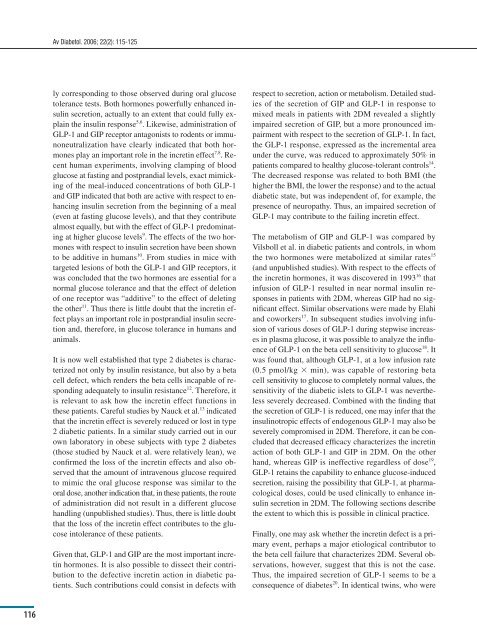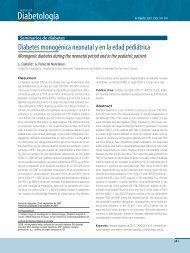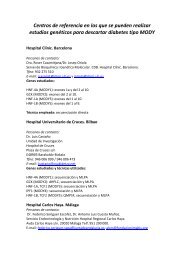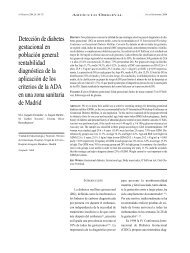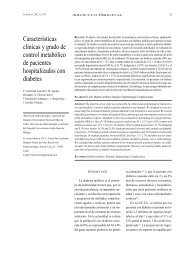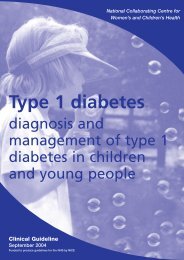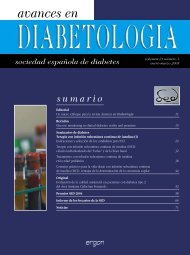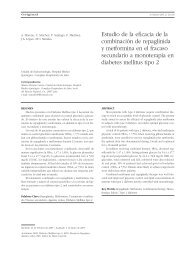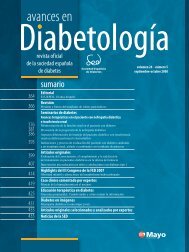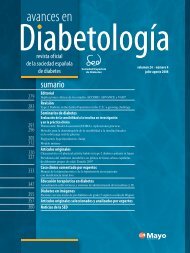Descargar - Sociedad Española de Diabetes
Descargar - Sociedad Española de Diabetes
Descargar - Sociedad Española de Diabetes
You also want an ePaper? Increase the reach of your titles
YUMPU automatically turns print PDFs into web optimized ePapers that Google loves.
Av Diabetol. 2006; 22(2): 115-125<br />
ly corresponding to those observed during oral glucose<br />
tolerance tests. Both hormones powerfully enhanced insulin<br />
secretion, actually to an extent that could fully explain<br />
the insulin response 5,6 . Likewise, administration of<br />
GLP-1 and GIP receptor antagonists to ro<strong>de</strong>nts or immunoneutralization<br />
have clearly indicated that both hormones<br />
play an important role in the incretin effect 7,8 . Recent<br />
human experiments, involving clamping of blood<br />
glucose at fasting and postprandial levels, exact mimicking<br />
of the meal-induced concentrations of both GLP-1<br />
and GIP indicated that both are active with respect to enhancing<br />
insulin secretion from the beginning of a meal<br />
(even at fasting glucose levels), and that they contribute<br />
almost equally, but with the effect of GLP-1 predominating<br />
at higher glucose levels 9 . The effects of the two hormones<br />
with respect to insulin secretion have been shown<br />
to be additive in humans 10 . From studies in mice with<br />
targeted lesions of both the GLP-1 and GIP receptors, it<br />
was conclu<strong>de</strong>d that the two hormones are essential for a<br />
normal glucose tolerance and that the effect of <strong>de</strong>letion<br />
of one receptor was “additive” to the effect of <strong>de</strong>leting<br />
the other 11 . Thus there is little doubt that the incretin effect<br />
plays an important role in postprandial insulin secretion<br />
and, therefore, in glucose tolerance in humans and<br />
animals.<br />
It is now well established that type 2 diabetes is characterized<br />
not only by insulin resistance, but also by a beta<br />
cell <strong>de</strong>fect, which ren<strong>de</strong>rs the beta cells incapable of responding<br />
a<strong>de</strong>quately to insulin resistance 12 . Therefore, it<br />
is relevant to ask how the incretin effect functions in<br />
these patients. Careful studies by Nauck et al. 13 indicated<br />
that the incretin effect is severely reduced or lost in type<br />
2 diabetic patients. In a similar study carried out in our<br />
own laboratory in obese subjects with type 2 diabetes<br />
(those studied by Nauck et al. were relatively lean), we<br />
confirmed the loss of the incretin effects and also observed<br />
that the amount of intravenous glucose required<br />
to mimic the oral glucose response was similar to the<br />
oral dose, another indication that, in these patients, the route<br />
of administration did not result in a different glucose<br />
handling (unpublished studies). Thus, there is little doubt<br />
that the loss of the incretin effect contributes to the glucose<br />
intolerance of these patients.<br />
Given that, GLP-1 and GIP are the most important incretin<br />
hormones. It is also possible to dissect their contribution<br />
to the <strong>de</strong>fective incretin action in diabetic patients.<br />
Such contributions could consist in <strong>de</strong>fects with<br />
respect to secretion, action or metabolism. Detailed studies<br />
of the secretion of GIP and GLP-1 in response to<br />
mixed meals in patients with 2DM revealed a slightly<br />
impaired secretion of GIP, but a more pronounced impairment<br />
with respect to the secretion of GLP-1. In fact,<br />
the GLP-1 response, expressed as the incremental area<br />
un<strong>de</strong>r the curve, was reduced to approximately 50% in<br />
patients compared to healthy glucose-tolerant controls 14 .<br />
The <strong>de</strong>creased response was related to both BMI (the<br />
higher the BMI, the lower the response) and to the actual<br />
diabetic state, but was in<strong>de</strong>pen<strong>de</strong>nt of, for example, the<br />
presence of neuropathy. Thus, an impaired secretion of<br />
GLP-1 may contribute to the failing incretin effect.<br />
The metabolism of GIP and GLP-1 was compared by<br />
Vilsboll et al. in diabetic patients and controls, in whom<br />
the two hormones were metabolized at similar rates 15<br />
(and unpublished studies). With respect to the effects of<br />
the incretin hormones, it was discovered in 1993 16 that<br />
infusion of GLP-1 resulted in near normal insulin responses<br />
in patients with 2DM, whereas GIP had no significant<br />
effect. Similar observations were ma<strong>de</strong> by Elahi<br />
and coworkers 17 . In subsequent studies involving infusion<br />
of various doses of GLP-1 during stepwise increases<br />
in plasma glucose, it was possible to analyze the influence<br />
of GLP-1 on the beta cell sensitivity to glucose 18 . It<br />
was found that, although GLP-1, at a low infusion rate<br />
(0.5 pmol/kg min), was capable of restoring beta<br />
cell sensitivity to glucose to completely normal values, the<br />
sensitivity of the diabetic islets to GLP-1 was nevertheless<br />
severely <strong>de</strong>creased. Combined with the finding that<br />
the secretion of GLP-1 is reduced, one may infer that the<br />
insulinotropic effects of endogenous GLP-1 may also be<br />
severely compromised in 2DM. Therefore, it can be conclu<strong>de</strong>d<br />
that <strong>de</strong>creased efficacy characterizes the incretin<br />
action of both GLP-1 and GIP in 2DM. On the other<br />
hand, whereas GIP is ineffective regardless of dose 19 ,<br />
GLP-1 retains the capability to enhance glucose-induced<br />
secretion, raising the possibility that GLP-1, at pharmacological<br />
doses, could be used clinically to enhance insulin<br />
secretion in 2DM. The following sections <strong>de</strong>scribe<br />
the extent to which this is possible in clinical practice.<br />
Finally, one may ask whether the incretin <strong>de</strong>fect is a primary<br />
event, perhaps a major etiological contributor to<br />
the beta cell failure that characterizes 2DM. Several observations,<br />
however, suggest that this is not the case.<br />
Thus, the impaired secretion of GLP-1 seems to be a<br />
consequence of diabetes 20 . In i<strong>de</strong>ntical twins, who were<br />
116


